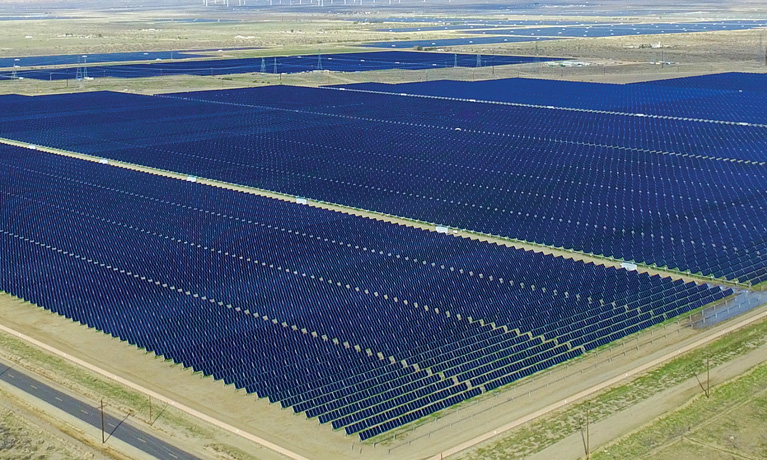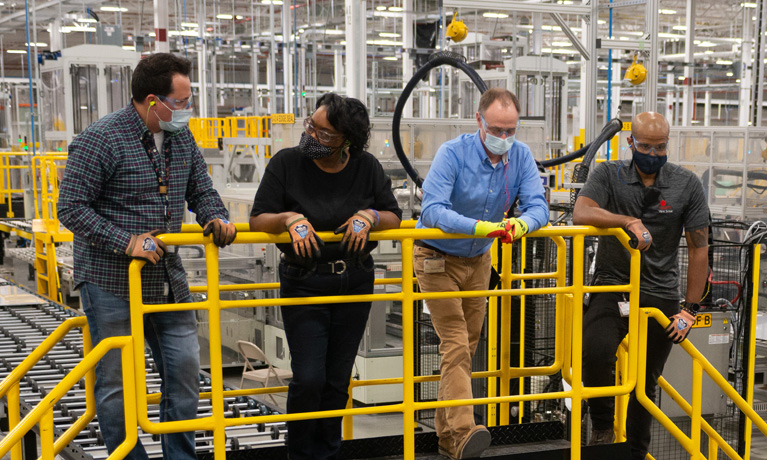The value of American vertically integrated solar manufacturing at scale
First Solar is enabled by thousands of hardworking people across the country who support our American value chain.
We recognize the need to quantify the real extent of our contribution to the US economy -- the real value of solar technology that is made in America, and not simply assembled here using imported components.
First Solar commissioned a comprehensive economic analysis, conducted by the Kathleen Babineaux Blanco Public Policy Center at the University of Louisiana, Lafayette, to map First Solar’s impact on America in meaningful terms: jobs, economic output, and value created in 2023 and forecasts for 2026 when we expect to achieve 14 GW of annual nameplate capacity across the US.

The analysis considers the economic benefits of the company’s operations in 2023, which it ended with over 6 GW of operational US capacity. The study also examines planned operational expenditures in 2026, when a major expansion is expected to be complete. Finally, researchers evaluated the economic impacts of constructing First Solar’s facilities in Ohio, Alabama, and Louisiana in 2023.
“All of First Solar’s activities are considered new to the national economy because in the absence of First Solar, it is likely that demand for solar panels would be met by a foreign company given the concentration of solar manufacturing overseas, especially in China.”
“First Solar’s facility in Lawrence County represents the largest single investment project for rural Alabama in many years, and I am thrilled to see this world-class company create solid career opportunities for the region’s hard-working citizens. I know that the First Solar manufacturing facility will have a major economic impact on this part of ‘Sweet Home Alabama.’”
– Governor Kay Ivey, Alabama
“First Solar’s new manufacturing facility in Iberia Parish will employ roughly 700 people, bringing good jobs and economic value to our State. It is important that our solar industry be domestic, and not in relation to China. I appreciate their work here in Louisiana, and I look forward to the opportunities this facility will bring.”
– Governor Jeff Landry, Louisiana


2023 Operational Impacts
While First Solar is currently undergoing a rapid expansion, the company’s 2023 operations are estimated to support a total of 16,245 direct, indirect, and induced jobs and nearly $1.6 billion in labor income in the US economy. The company’s operations are also estimated to support a total of nearly $2.8 billion in value added and almost $5.3 billion in total output when including indirect and induced economic effects.
2026 Projected Operational Impacts
After the ongoing expansions in Alabama, Louisiana, and Ohio are complete, annual operational impacts on the US economy starting in 2026 are projected to grow to a total of more than 30,000 jobs and almost $2.8 billion in labor income. Operating at that scale will support nearly $5 billion in value added and over $10 billion in output to the US economy including direct, indirect, and induced economic effects.



2023 Construction Impacts
First Solar’s construction activities in 2023 are estimated to create a total of 5,765 jobs and $637.8 million in labor income nationally including indirect and induced effects. These activities are also estimated to have supported more than $900 million in value added and $1.9 billion in output, or total sales, within the national economy.
Between 2016 and 2026, the company expects to have invested approximately $4 billion in manufacturing and research and development infrastructure in the United States, demonstrating its commitment to America.
While the unique impacts of a specific industry, or company, can vary based on a wide range of factors, First Solar’s impacts can be attributed at least in part to longstanding efforts to cultivate a domestic supply chain, which helps capture a larger portion of indirect and induced economic activities within the national economy.


100% American Steel and Glass
First Solar’s American-made solar panels are produced with American-made glass and steel. Significantly, First Solar’s steel value chain is located within a 100-mile radius of its Perrysburg campus, with steel made in Cleveland, processed in Delta, and fabricated into back rails in Bowling Green. Additionally, First Solar is one of the largest buyers of American-made float glass, consuming approximately 15% of the country’s capacity.
- Capital Expenditure Impact: The economic effects resulting from the company’s investments in capital assets or infrastructure. This includes the construction, maintenance, or improvement of long-term assets such as buildings, factories, equipment, machinery, or technology.
- Direct Impact: The immediate effects generated by the company’s activities, such as employment, salaries and wages, and direct spending on goods and services.
- Employment Impact: The effect of the business’s activities on job creation or loss, including both direct employment within the company and indirect employment in related industries.
- Indirect Impact: The secondary effects resulting from the spending of businesses in the supply chain associated with the company, including supplier purchases and additional economic activity stimulated by the company’s operations.
- Induced Impact: The broader economic effects that arise from the spending of employees and other individuals who receive income directly or indirectly from the company, such as household spending.
- Labor Income: The total wages and salaries of direct and indirect workers associated with the company, including the value of employment benefits.
- Operational Expenditure Impact: The effects that a company’s day-to-day operations and activities have on the economy, including production output, employment levels, and purchases of goods and services from suppliers to run the business.
- Output: The total economic output generated by the company, encompassing the value of goods and services produced and sold by its operations.
- Ratio or Multiplier Effect: The amplification of economic impact as money circulates throughout the economy, creating a ripple effect beyond the initial investment or spending.
- Value Added: The contribution of the company to the economy, or GDP, measured by the difference between its total revenue and the cost of intermediate goods and services purchased.





